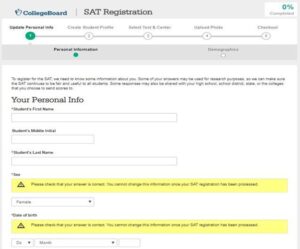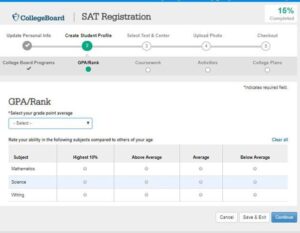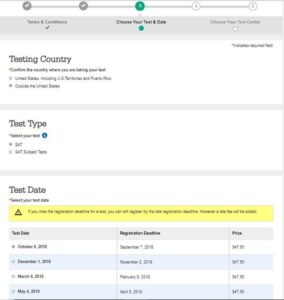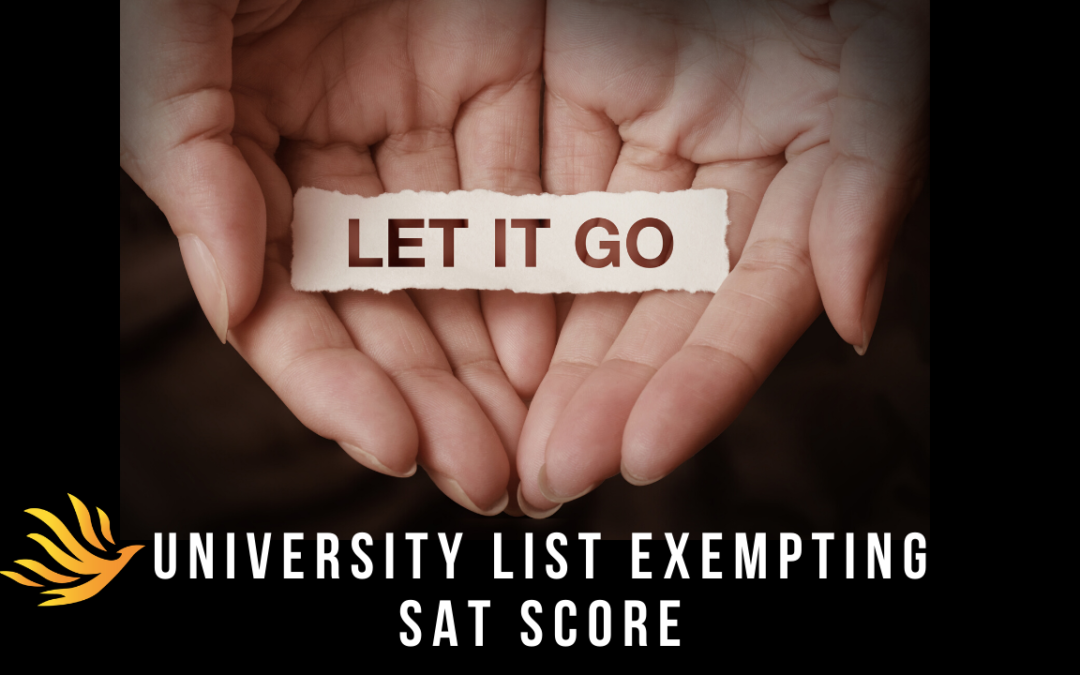


SAT-Tips for a smooth exam
DON’T study
Eat a light, but filling breakfast
Sleep early
Go in with a positive attitude for SAT

SAT Going Digital in 2023: How to Prepare for the Changes!
The Digital SAT is here! The college boards will be taking a major step forward in March 2023, as it will introduce a simplified version of its signature test an entirely digital test for international test-takers. This shift away from the traditional paper format of the standardized exam is poised to bring a number of benefits, such as shorter exam times, increased flexibility, more focused reading sections with adaptive sections, and more. The college board will also be adding two more international test dates in 2023 to match the number of administrations for students in the United States.
Overall, this shift to a digital format is sure to make the SAT process easier and more
accessible for international students who wish to pursue higher education abroad! Going
forward, it’s important for students to stay informed about the latest changes and updates so
they can be best prepared when taking the SAT.
The Digital SAT: Everything You Need to Know
As the college admissions process continues to evolve, so too does the SAT. The College
Board has recently made the bold decision to transition its iconic test into a digital format –
and it’s no surprise why. For students and proctors alike, the digital version of the SAT
promises more efficiency, flexibility, and focus than ever before. Let’s take a look at what
exactly is changing with the Digital SAT and learn some tips on how to best prepare for this
new online format.
Shorter Exam Time
The most noticeable change with the Digital SAT is that its total duration has been cut from 3
hours to 2 hours. This is great news for both students and proctors, as it significantly
reduces the amount of time spent taking or administering the test. However, keep in mind
that although less time may be allotted for completion, it doesn’t necessarily mean that you’ll
be able to breeze through each section; rather, you will still need to ensure that you manage
your time wisely in order to maximize your overall score potential!
Flexible Format
Another notable change with the Digital SAT is that it will now be available in two formats –
laptop or tablet device– allowing students the opportunity to choose which one they are most
comfortable with during their test-taking experience. And if you already own either a laptop
or tablet device? Even better! All you have to do is bring your device fully charged on exam
day and make sure that it meets certain hardware requirements (which can easily be found
online).
More Focused Reading Section Passages & Questions
The reading section of this revised version of the SAT will also include some key changes.
Instead of featuring multiple questions per passage like before (10-11), there will now only
be one question per passage. This eliminates any confusion regarding which questions
correspond with which passages thus helping improve focus while simultaneously providing
an opportunity for readers to assess their comprehension skills without having to worry about
tackling multiple questions at once. Additionally, passages featured in this section will be
chosen based upon topics carefully selected by examiners who understand what today’s
youth find interesting and relevant– not outdated or esoteric concepts like before!
Adaptive Sections & Calculator Permission in Math Section
For perhaps the first major time ever, sections within this new iteration of the SAT will feature
an adaptive format – meaning that questions become harder or easier depending on
whether your answers were correct or incorrect respectively within a given section – similar
to other standardized tests such as GRE exams . Plus, unlike before where calculators were
only allowed during certain parts of math section , calculators are now permitted throughout
its entirety across all levels– allowing those who are already familiar with using such tools a
chance to demonstrate their mathematical reasoning ability without being disadvantaged
simply because they prefer working with calculators during tests . So don’t forget about
bringing your calculator along on exam day if you plan on utilizing it during your math
sections !
Quick Results & Other Remaining Aspects
Thanks to advancements such as automated scoring and real-time reporting of scores ,
students can expect scorecards released within days instead of waiting two weeks like
before . Furthermore, other aspects remain unchanged such as its 1,600 scale point system
, as well as proctor administration by qualified professionals in approved testing centers
(making taking this exam from home impossible ).
Conclusion
At its core, transitioning into a digital format allows College Board administrators both old
and new alike an exciting opportunity not just advance technology but also promote student
engagement when selecting passage topics ! For those preparing for this upcoming version
of the SAT , here are some key tips: practice beforehand using online resources; get enough sleep; eliminate distractions while testing ; stay calm; and always remember your calculator !
Good luck !
How to register for SAT?
Guide to register for SAT Online
STEP 1 : www.collegeboard.org (Official SAT registration website)
STEP 2 : sign in – If you already have an account
IF NOT
Sign UP – to create login ID and password
- Apart from personal details like name, address, etc they will ask high school graduation date – you should enter 12th pass month and year for eg: June – 2022.
- They will also ask you to search your school name- if not found in the list – select school not listed.
The first page of College Board SAT registration form looks like this:

- After entering the details, you will receive a page to enter Username, Password, and Security Question. They will get the preview and by confirming it they will receive an e-mail in their registered email ID and can proceed to fill the SAT registration form.
Step 3: Fill the SAT Registration Application Form
In the next step of SAT exam registration 2021, you need to Log in using your username and password and click on register for SAT. After this, they will need to provide their:
- Personal information, high school information, and mailing address
- Demographic information and information about parents
- Enter academic information like GPA/Rank, Course works, Extracurricular activities, and College details; Financial Aid; Part-time Employment, etc.
- Answer only those questions which are compulsory (marked with an *) rest can be left blank.
- You can skip the entire survey questions.

Step 4: Booking SAT Test Dates and Center
On providing the details of the testing country, you will get a list of SAT registration dates and SAT exam centres to select from. After SAT dates and center selection process is complete, you may go ahead and pay SAT registration cost.

SAT Exam Fees in India
The fee for attempting the test in India is $101 for the SAT without the optional Essay and $117 with the Essay – both inclusive of an International Fee of $49. If you change your SAT exam date or Center, an additional $30 is charged.
If you need any assistance to register for SAT, feel free to get in touch.

SAT Updates: Universities exempting SAT scores for 2020-21
Find below the list of Universities exemptign SAT scores due to the prevailing situation of Covid-19. This list does not include the Universities which already had waiver for SATs.
| University Name | Location |
| Adelphi College | Garden City, NY |
| Alabama A & M | Huntsville, AL |
| Alabama State University | Montgomery, AL |
| Albion College | Albion, MI |
| Alma College | Alma, MI |
| Amherst College | Amherst, MA |
| Austin Peay State University | Clarksville, TN |
| Auburn University at Montgomery | Montgomery, AL |
| Bethany College | Bethany, WV |
| Bismarck State College | Bismarck, ND |
| Bluefield State University | Bluefield, WV |
| Boston University | Boston, MA |
| Brigham Young University | Provo, UT |
| Case Western Reserve University | Cleveland, OH |
| Central College | Pella, IA |
| Cleveland State College | Cleveland, TN |
| Concordia University Texas | Austin, TX |
| Cornell University | Ithaca, NY |
| Cottey College | Nevada, MO |
| Davidson College | Davidson, NC |
| Drury University | Springfield, MO |
| Fairmont State University | Fairmont, WV |
| Franklin College | Franklin, IN |
| Haverford College | Haverford, PA |
| Indiana University Kokomo | Kokomo, IN |
| Indiana University Northwest | Gary, IN |
| Indiana University Southeast | New Albany, IN |
| Indiana Wesleyan University | Marion, IN |
| Iowa Wesleyan University | Mt. Pleasant, IA |
| Jackson State University | Jackson, MS |
| Kent State University | Kent, OH |
| Kutztown University | Kutztown, PA |
| Lamar University | Beaumont, TX |
| Limestone College | Gaffney, SC |
| Lock Haven University | Lock Haven, PA |
| Longwood University | Farmville, VA |
| Malone University | Canton, OH |
| Mansfield University | Mansfield, PA |
| Marymount Manhattan College | New York City, NY |
| Midway University | Midway, KY |
| Millersville University | Millersville, PA |
| Millikin University | Decatur, IL |
| Minnesota State University, Moorhead | Moorhead, MN |
| Mississippi College | Clinton, MS |
| Newberry College | Newberry, SC |
| Northeastern University | Boston, MA |
| Northern Kentucky University | Highland Heights, KY |
| Ohio University | Athens, OH |
| Oregon State University | Corvallis, OR |
| Pomona College | Claremont, CA |
| Portland State University | Portland, OR |
| Rhodes College | Memphis, TN |
| Rutgers University-Newark | Newark, NJ |
| Saint Vincent College | Latrobe, PA |
| Southern Oregon University | Ashland, OR |
| St. Mary’s University | San Antonio, TX |
| St. Thomas Aquinas College | Sparkill, NY |
| St. Thomas University | Miami Gardens, FL |
| Savannah College of Arts and Design | Savannah, GA |
| Scripps College | Claremont, CA |
| Southwest Baptist University | Bolivar, MO |
| Texas Christian University | Fort Worth, TX |
| Thiel College | Greenville, PA |
| Trinity University | San Antonio, TX |
| Tufts University | Medford, MA |
| Tulane University | New Orleans, LA |
| University of Akron | Akron, OH |
| University of Alaska Fairbanks | Fairbanks, AK |
| University of California, Berkeley | Berkeley, CA |
| University of California, Davis | Davis, CA |
| University of California, Irvine | Irvine, CA |
| University of California, Los Angeles | Los Angeles, CA |
| University of California, Merced | Merced, CA |
| University of California, Riverside | Riverside, CA |
| University of California, San Diego | San Diego, CA |
| University of California, San Francisco | San Francisco, CA |
| University of California, Santa Barbara | Santa Barbara, CA |
| University of California, Santa Cruz | Santa Cruz, CA |
| University of the Cumberlands | Williamsburg, KY |
| University of Dayton | Dayton, OH |
| University of Mount Union | Alliance, OH |
| University of Nevada–Las Vegas | Las Vegas, NV |
| University of Nevada–Reno | Reno, NV |
| University of North Dakota–Grand Forks | Grand Forks, ND |
| University of Oregon | Eugene, OR |
| University of Pittsburgh-Bradford | Bradford, PA |
| University of Pittsburgh-Greensburg | Greensburg, PA |
| University of Pittsburgh-Johnstown | Johnstown, PA |
| University of Pittsburgh-Titusville | Titusville, PA |
| University of Virginia–Wise | Wise, VA |
| University of Washington | Seattle, WA |
| Vassar College | Poughkeepsie, NY |
| Washington State University Vancouver | Vancouver, WA |
| Wayne State University | Detroit, MI |
| Western Michigan University | Kalamazoo, MI |
| Westminster College | Salt Lake City, UT |
| West Virginia State University | Institute, WV |
| Williams College | Williamstown, MA |
| Winthrop University | Rock Hill, SC |
Source: Fairtest, Prepscholar, Washingtonpost

Recent Comments